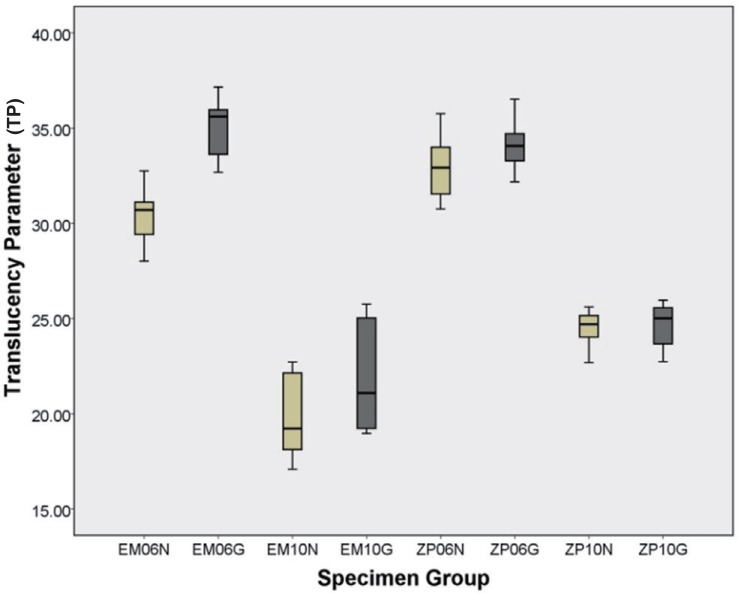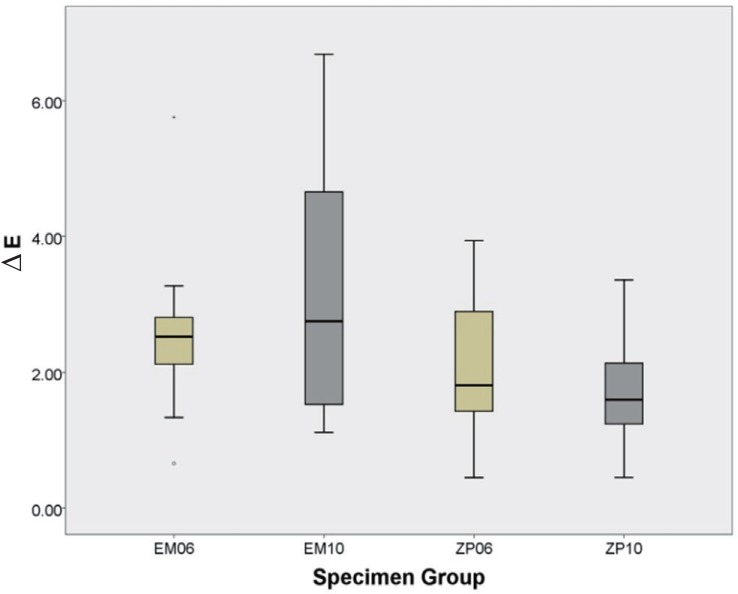J Adv Prosthodont.
2019 Feb;11(1):16-22. 10.4047/jap.2019.11.1.16.
Color changes of ceramic veneers following glazing with respect to their composition
- Affiliations
-
- 1Department of Dentistry, School of Medicine, Jeju National University, Jeju, Republic of Korea. sehoon.kahm@gmail.com
- 2Department of Dentistry, Jeju National University Hospital, Jeju, Republic of Korea.
- 3School of Medicine, Jeju National University, Jeju, Republic of Korea.
- 4Graduate School of Medicine, the Catholic University of Korea, Seoul, Republic of Korea.
- KMID: 2438927
- DOI: http://doi.org/10.4047/jap.2019.11.1.16
Abstract
- PURPOSE
The purpose of this study was to compare the translucency and color changes of ceramic laminate veneers of different composition following glazing process.
MATERIALS AND METHODS
10 mm × 10 mm square specimens of 0.6 mm and 1.0 mm thicknesses were fabricated with IPS e.max Press (EM) and IPS e.max ZirPress (ZP) (n=10 per group). The color coordinates (CIE L* a* b*) of the specimens were recorded with a colorimeter before and after glazing. The color changes and translucency parameter (TP) were calculated. For the comparisons with the composition and thicknesses between the "˜not glazed' and "˜glazed' groups, statistical analyses were done through paired T-test, independent two-sample T-test, and multiple regression analysis using SPSS 18.0 (P < .05).
RESULTS
The TP of 0.6 mm EM was higher than that of 0.6 mm ZP. Total color difference (ΔE*) between bare and glazed specimens of 1.0 mm EM was greater than that of 1.0 mm ZP with statistical significance. Following glazing, specimens from all groups showed statistically significant amount of decrease in L* and a*, and statistically significant increase in b*. The result of multiple regression analysis of EM and ZP showed that ΔL* improved ΔE*.
CONCLUSION
Within the limitations of present study, we conclude that translucency and color of ceramic laminate veneers change significantly after glazing process, and the nature and amount of changes vary with different compositions.
Keyword
MeSH Terms
Figure
Reference
-
1. Ryu SY, Lim JH, Cho IH. A study on the color stability of porcelain for porcelain fused to metal crown. J Korean Acad Prosthodont. 2000; 38:73–84.2. Joiner A. Tooth colour: a review of the literature. J Dent. 2004; 32(Suppl 1):3–12.
Article3. Al Ben Ali A, Kang K, Finkelman MD, Zandparsa R, Hirayama H. The effect of variations in translucency and background on color differences in CAD/CAM lithium disilicate glass ceramics. J Prosthodont. 2014; 23:213–220. PMID: 23889762.
Article4. Barizon KT, Bergeron C, Vargas MA, Qian F, Cobb DS, Gratton DG, Geraldeli S. Ceramic materials for porcelain veneers: part II. Effect of material, shade, and thickness on translucency. J Prosthet Dent. 2014; 112:864–870. PMID: 24969410.
Article5. Yilmaz C, Korkmaz T, Demirköprülü H, Ergün G, Ozkan Y. Color stability of glazed and polished dental porcelains. J Prosthodont. 2008; 17:20–24. PMID: 17971115.6. Wiskott HWA. Fixed prosthodontics: principles and clinics. London, UK: Quintessence publishing;2011. p. 670–671.7. Choi BB, Woo YH, Kim HS. Contemporary fixed prosthodontics. 3rd ed. Seoul, Korea: Jisung Publishing;2003. p. 645.8. Yılmaz K, Gonuldas F, Ozturk C. The effect of repeated firings on the color change of dental ceramics using different glazing methods. J Adv Prosthodont. 2014; 6:427–433. PMID: 25551001.
Article9. Obregon A, Goodkind RJ, Schwabacher WB. Effects of opaque and porcelain surface texture on the color of ceramometal restorations. J Prosthet Dent. 1981; 46:330–340. PMID: 7021809.
Article10. Heffernan MJ, Aquilino SA, Diaz-Arnold AM, Haselton DR, Stanford CM, Vargas MA. Relative translucency of six all-ceramic systems. Part II: core and veneer materials. J Prosthet Dent. 2002; 88:10–15. PMID: 12239473.
Article11. Chu FC, Chow TW, Chai J. Contrast ratios and masking ability of three types of ceramic veneers. J Prosthet Dent. 2007; 98:359–364. PMID: 18021824.
Article12. Spear F, Holloway J. Which all-ceramic system is optimal for anterior esthetics? J Am Dent Assoc. 2008; 139(Suppl):19S–24S.
Article13. Kim SJ, Son HH, Cho BH, Lee IB, Um CM. Translucency and masking ability of various opaque-shade composite resins. J Dent. 2009; 37:102–107. PMID: 19028004.
Article14. Sinmazisik G, Demirbas B, Tarcin B. Influence of dentin and core porcelain thickness on the color of fully sintered zirconia ceramic restorations. J Prosthet Dent. 2014; 111:142–149. PMID: 24189117.
Article15. Kim SJ, Kahm SH. Translucency of ceramic veneers on glazing effect. J Korean Acad Prosthodont. 2015; 53:138–143.
Article16. Kahm SH, Lee BJ, Seo MS, Kim SJ. Color difference of lithium disilicate ceramic veneer on glazing effect. Oral Biol Res. 2016; 40:124–128.17. Kahm SH, Heo UC, Kim SJ. Color change of lithium disilicate ceramic veneer on different thicknesses with and without glazing. Oral Biol Res. 2017; 41:8–14.
Article18. British standard specification for dental porcelains for jacket crowns. BS5612. London, UK: British Standard Institution;1978.19. Johnston WM, Ma T, Kienle BH. Translucency parameter of colorants for maxillofacial prostheses. Int J Prosthodont. 1995; 8:79–86. PMID: 7710631.20. Santos MO, do Amaral FL, França FM, Basting RT. Influence of translucence/opacity and shade in the flexural strength of lithium disilicate ceramics. J Conserv Dent. 2015; 18:394–398. PMID: 26430304.
Article21. Bagis B, Turgut S. Optical properties of current ceramics systems for laminate veneers. J Dent. 2013; 41(Suppl 3):e24–e30.
Article22. Wang H, Xiong F, Zhenhua L. Influence of varied surface texture of dentin porcelain on optical properties of porcelain specimens. J Prosthet Dent. 2011; 105:242–248. PMID: 21458649.
Article23. Awad D, Stawarczyk B, Liebermann A, Ilie N. Translucency of esthetic dental restorative CAD/CAM materials and composite resins with respect to thickness and surface roughness. J Prosthet Dent. 2015; 113:534–540. PMID: 25749093.
Article24. Jeong ID, Bae SY, Kim DY, Kim JH, Kim WC. Translucency of zirconia-based pressable ceramics with different core and veneer thicknesses. J Prosthet Dent. 2016; 115:768–772. PMID: 26794702.
Article25. Kurtulmus-Yilmaz S, Ulusoy M. Comparison of the translucency of shaded zirconia all-ceramic systems. J Adv Prosthodont. 2014; 6:415–422. PMID: 25352964.
Article26. Kuehni RG, Marcus RT. An experiment in visual scaling of small color differences. Color Res Appl. 1979; 4:83–91.27. Ragain JC, Johnston WM. Color acceptance of direct dental restorative materials by human observers. Color Res Appl. 2000; 25:278–285.
Article28. Ruyter IE, Nilner K, Moller B. Color stability of dental composite resin materials for crown and bridge veneers. Dent Mater. 1987; 3:246–251. PMID: 3479360.
Article29. Johnston WM, Kao EC. ssessment of appearance match by visual observation and clinical colorimetry. J Dent Res. 1989; 68:819–822. PMID: 2715476.
- Full Text Links
- Actions
-
Cited
- CITED
-
- Close
- Share
- Similar articles
-
- Translucency of ceramic veneers on glazing effect
- The effect of repeated firings on the color change of dental ceramics using different glazing methods
- A Study On The Color Stability Of Porcelain For Porcelain Fused To Metal Crown
- Effect on the Color Stability of Stained Porcelain due to Tooth Brushing
- Effect of polishing and glazing on the color and spectral distribution of monolithic zirconia



